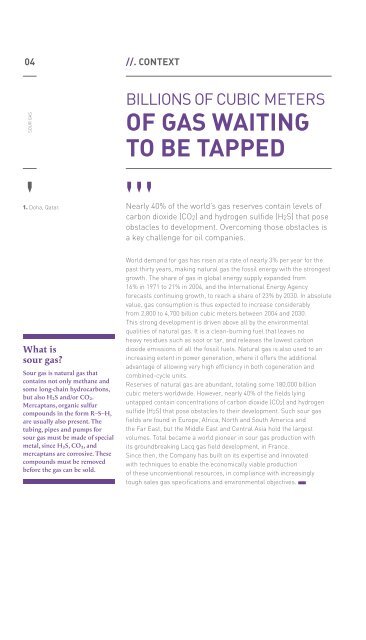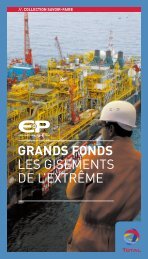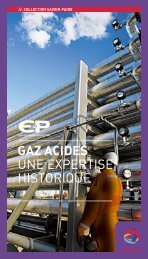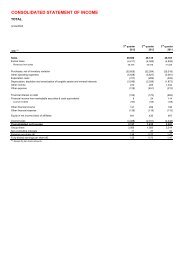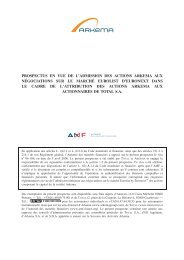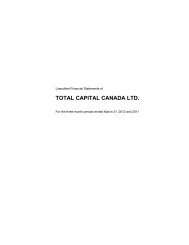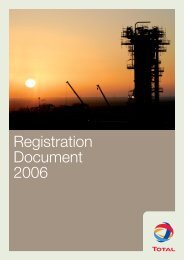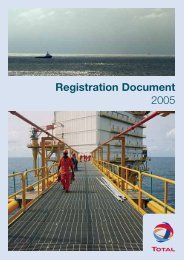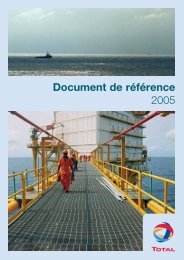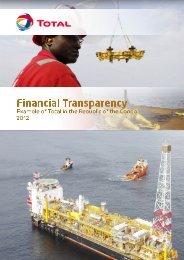Sour gas - A history of expertise - Total.com
Sour gas - A history of expertise - Total.com
Sour gas - A history of expertise - Total.com
You also want an ePaper? Increase the reach of your titles
YUMPU automatically turns print PDFs into web optimized ePapers that Google loves.
04<br />
SOUR GAS<br />
s<br />
1. Doha, Qatar.<br />
What is<br />
sour <strong>gas</strong>?<br />
<strong>Sour</strong> <strong>gas</strong> is natural <strong>gas</strong> that<br />
contains not only methane and<br />
some long-chain hydrocarbons,<br />
but also H2S and/or CO2.<br />
Mercaptans, organic sulfur<br />
<strong>com</strong>pounds in the form R–S–H,<br />
are usually also present. The<br />
tubing, pipes and pumps for<br />
sour <strong>gas</strong> must be made <strong>of</strong> special<br />
metal, since H2S, CO2, and<br />
mercaptans are corrosive. These<br />
<strong>com</strong>pounds must be removed<br />
before the <strong>gas</strong> can be sold.<br />
//. Context<br />
Billions <strong>of</strong> cuBic mEtErs<br />
<strong>of</strong> GAs wAitinG<br />
to be tApped<br />
s s s<br />
Nearly 40% <strong>of</strong> the world’s <strong>gas</strong> reserves contain levels <strong>of</strong><br />
carbon dioxide (CO2) and hydrogen sulfide (H2S) that pose<br />
obstacles to development. Over<strong>com</strong>ing those obstacles is<br />
a key challenge for oil <strong>com</strong>panies.<br />
World demand for <strong>gas</strong> has risen at a rate <strong>of</strong> nearly 3% per year for the<br />
past thirty years, making natural <strong>gas</strong> the fossil energy with the strongest<br />
growth. The share <strong>of</strong> <strong>gas</strong> in global energy supply expanded from<br />
16% in 1971 to 21% in 2004, and the International Energy Agency<br />
forecasts continuing growth, to reach a share <strong>of</strong> 23% by 2030. In absolute<br />
value, <strong>gas</strong> consumption is thus expected to increase considerably<br />
from 2,800 to 4,700 billion cubic meters between 2004 and 2030.<br />
This strong development is driven above all by the environmental<br />
qualities <strong>of</strong> natural <strong>gas</strong>. It is a clean-burning fuel that leaves no<br />
heavy residues such as soot or tar, and releases the lowest carbon<br />
dioxide emissions <strong>of</strong> all the fossil fuels. Natural <strong>gas</strong> is also used to an<br />
increasing extent in power generation, where it <strong>of</strong>fers the additional<br />
advantage <strong>of</strong> allowing very high efficiency in both cogeneration and<br />
<strong>com</strong>bined-cycle units.<br />
Reserves <strong>of</strong> natural <strong>gas</strong> are abundant, totaling some 180,000 billion<br />
cubic meters worldwide. However, nearly 40% <strong>of</strong> the fields lying<br />
untapped contain concentrations <strong>of</strong> carbon dioxide (CO2) and hydrogen<br />
sulfide (H2S) that pose obstacles to their development. Such sour <strong>gas</strong><br />
fields are found in Europe, Africa, North and South America and<br />
the Far East, but the Middle East and Central Asia hold the largest<br />
volumes. <strong>Total</strong> became a world pioneer in sour <strong>gas</strong> production with<br />
its groundbreaking Lacq <strong>gas</strong> field development, in France.<br />
Since then, the Company has built on its <strong>expertise</strong> and innovated<br />
with techniques to enable the economically viable production<br />
<strong>of</strong> these unconventional resources, in <strong>com</strong>pliance with increasingly<br />
tough sales <strong>gas</strong> specifications and environmental objectives. nnn


